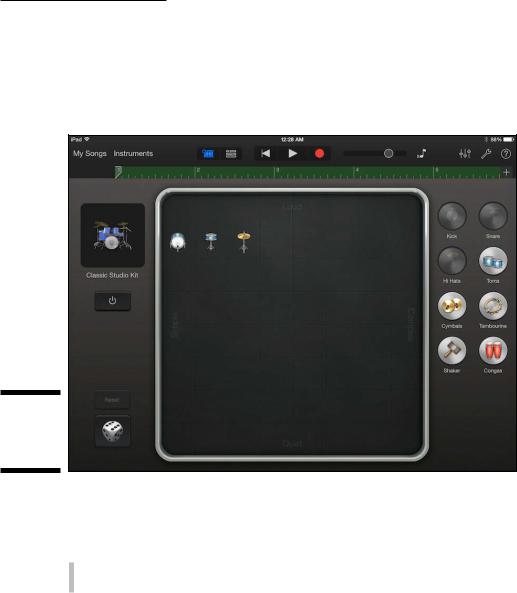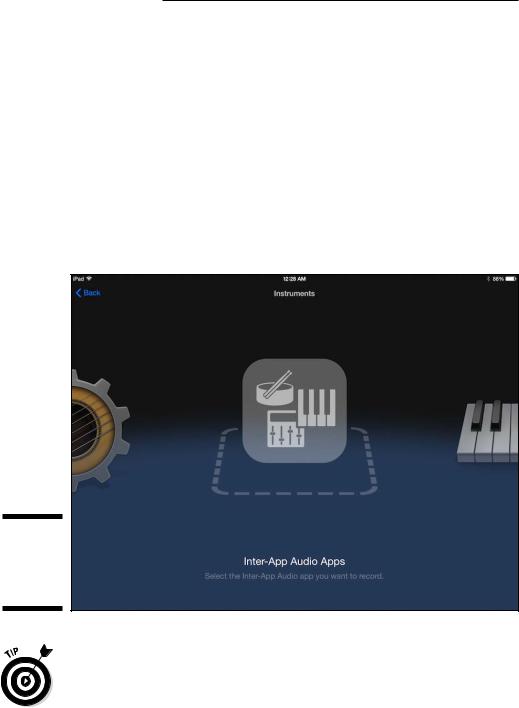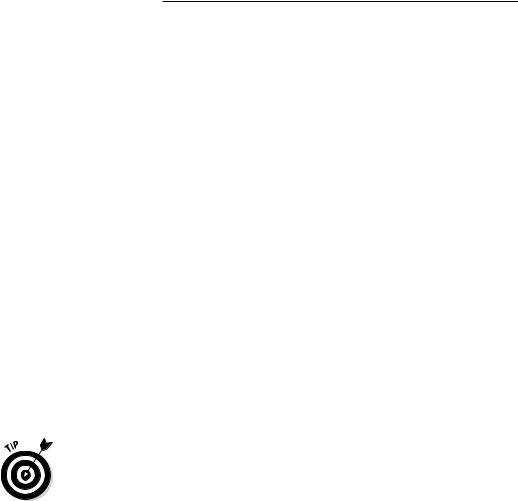
- •Contents at a Glance
- •Table of Contents
- •Introduction
- •About This Book
- •Foolish Assumptions
- •Icons Used in This Book
- •Beyond the Book
- •Where to Go from Here
- •Embracing Logic Pro
- •Transitioning from Other Software
- •Starting Your Project
- •Augmenting Your Project
- •Customizing Your Project Settings
- •Tidying Up Your Project
- •Navigating Logic Pro
- •Taking Inventory of Your Track List
- •Zooming Tracks
- •Your Logic Pro Toolbox
- •Keeping It Simple with Smart Controls
- •Navigating with Key Commands
- •Saving Workspaces with Screensets
- •Knowing Your Track Types
- •Around the Global Tracks
- •Sorting and Hiding Tracks
- •Knowing the Region Types
- •Editing Regions
- •Understanding Digital Audio
- •Connecting Your Audio Devices
- •Understanding MIDI
- •Connecting Your MIDI Devices
- •Preparing to Record Audio
- •Recording Your First Audio Take
- •Recording Multiple Takes in Cycle Mode
- •Recording Multiple Inputs
- •Punching In and Punching Out
- •Setting Up Multiple Monitor Mixes
- •Preparing to Record MIDI
- •Recording Your First MIDI Take
- •Creating Tracks in Cycle Mode
- •Overdubbing MIDI
- •Recording Multiple MIDI Inputs
- •Adding Apple Loops to Your Project
- •Adding Prerecorded Audio to Your Project
- •Importing Video to Your Project
- •Playing with Your Virtual Drummer
- •Creating Beats with Ultrabeat
- •Taking Stock of Vintage Instruments
- •Spinning Your Tonewheels with the Vintage B3
- •Funking Up the Vintage Clav
- •Getting the Tone of Tines with the Vintage Electric Piano
- •Fusing Four Synths with Retro Synth
- •Exploring the Logic Pro Synths
- •Sampling with the EXS24 Sampler
- •Modeling Sounds Using Sculpture
- •Building an Orchestral Template
- •Performing Your Orchestra
- •Traveling the World Instruments
- •Working in the Tracks Area
- •Showing Your Global Tracks
- •Beat Mapping Your Arrangement
- •Arranging Regions in the Tracks Area
- •Creating Folder Tracks
- •Using Groove Templates
- •Knowing Your Audio Editors
- •Time Traveling with Flex Time
- •Tuning with Flex Pitch
- •Editing Audio in the Audio File Editor
- •Knowing Your MIDI Editors
- •Editing MIDI in the Piano Roll Editor
- •Editing MIDI in the Step Editor
- •Editing MIDI in the Score Editor
- •Editing MIDI in the Event List Editor
- •Editing Your MIDI Environment
- •Knowing Your Channel Strip Types
- •Adjusting Channel Strip Controls
- •Adding Effects to Tracks
- •Controlling Signal Flow
- •Adjusting the EQ of Your Tracks
- •Adding Depth with Reverb and Delay
- •Adding or Removing Dynamics with Compression
- •Taking Track Notes
- •Turning Your Mix Into a Performance with Automation
- •Choosing Your Automation Mode
- •Adding Automation to Your Tracks
- •Recording Live Automation
- •Fine-Tuning EQ
- •Adding Multiband Compression
- •Turn It Up
- •Bouncing Your Project
- •Creating Stems and Alternate Mixes
- •Sharing Your Music
- •Playing Keys
- •Playing Guitar
- •Playing Drums
- •Editing Tracks and Your Arrangement
- •Using Your iPad Mixing Console
- •Recording Remotely
- •Commanding Logic Pro
- •Navigating Logic Pro
- •Sketching Songs with GarageBand
- •Importing iPad Audio
- •Use Key Commands
- •Use Screensets
- •Choose a Tool and Master It
- •Choose a Tool and Ignore It
- •Use the Fastest Way, Not the Right Way
- •Establish a Troubleshooting Strategy
- •Save and Back Up Frequently
- •Don’t Lose Sight of the Music
- •Index
- •About the Author

Chapter 20: Ten Ways to Use an iPad with Logic Pro X 343
GarageBand for iOS is a simple app to master. It has a limited feature set but gives you more recording and editing capabilities than The Beatles had in their early days. Plus, you can use its many auto-accompaniment features, such as smart drums, shown in Figure 20-8, to sketch new songs. Tap the settings icon (wrench) to open the GarageBand help system.
Figure 20-8:
Garage Band smart drums.
\\
GarageBand for Mac and iOS are both free apps. With your Logic Pro knowledge, I’m confident that you’ll master GarageBand quickly. To find out more about GarageBand for iOS and Mac, visit the following links:
\\http://logicstudiotraining.com/garagebandios
\\http://logicstudiotraining.com/garageband
Importing iPad Audio
GarageBand for iOS is capable of recording other music applications on your device through Inter-App Audio. Many iOS apps support the Inter-App Audio protocol. It’s a great way to get audio from your third-party synths and drum

344 Part VI: The Part of Tens
|
machines into GarageBand and, eventually, into Logic Pro. In GarageBand |
|
for iOS, here’s how to record audio from an app with Inter-App Audio |
|
capabilities: |
\ |
1.\ Tap the Instruments button, which is at the top of the interface. |
\ |
The touch instrument browser opens, as shown in Figure 20-9. |
\ |
2.\ In the instrument browser, choose Inter-App Audio Apps. |
\ |
The screen updates to show you apps capable of inter-app audio. |
\ |
3.\ Choose the app you want to add to your song.\ |
\ |
An audio track is added to your song using the output of your inter- |
|
app audio app. You can now record audio from the chosen app within |
|
GarageBand. |
Figure 20-9:
The Garage Band touch instrument browser.
\\
\You can also use third-party audio effects via Inter-App Audio. Some fantastic sounding guitar amp simulators can be used as an effect on your audio
tracks. Recording apps into GarageBand for iOS and then importing projects to your computer is a simple and effective way to get the most from your iPad, GarageBand, and Logic Pro X.

Chapter 21
Ten Tips to Speed Your Workflow
In This Chapter
\Getting organized and productive \Using key commands and screensets \Saving time with patches and presets \Troubleshooting and mastering Logic Pro
Finishing a Logic Pro project is like completing a puzzle: You have to fit all the pieces together to see the final picture. Some parts of the game
are more fun than others, so you need a good reason to see it through, such as the enjoyment of listening to your project come together. A better motivator is to make every moment that you create with Logic Pro a purposeful moment.
Start by giving your Logic Pro project deadlines and clear outcomes. If you don’t have a song to work on, create a learning project. I create projects to learn tools, workflows, plug-ins, and software instruments, in addition to songwriting and music producing. You’ll speed up your chops with experience, especially if your purpose is clear.
In this chapter, I offer practical tips to help you speed up your workflow and make more music.
I start almost every project by opening the project notes (Option- -P). I write a brief sentence about my project goal, and I sign my projects, adding my URL and copyright notice. That simple sentence alone will save you time as you search through projects for stuff. Sometimes I need to find a piece of music or an effects chain to use in a current project, and the search is much easier when each project has a short description in the notes.

346 Part VI: The Part of Tens
Project notes are also an ideal place to list all your deliverables. In Chapter 16, I list the fundamentals of mixing; I like to collect all that information in the project notes. I list reference tracks, effects ideas, track groups, bar numbers, lyrics, and anything else I can dump out of my brain. I also use project notes as a to-do list so I can keep track of what I’ve done and what’s left to do.
Use track notes to store specific information about the track, such as instrument frequency ranges and effects chains. I also keep a change log of significant edits and patches or channel strip settings. Sometimes, I’ll change the patch or channel strip setting of a track, but I always write down the name of the current patch. Keeping notes saves you from having to commit anything to memory, so you have more mental energy for the music.
Use Key Commands
You can use more than 1,200 key commands in Logic Pro X — many more than you’ll ever need. But many Logic Pro functions can be achieved only by key command, so one key command you should memorize is Option-K, which opens the key commands window.
If there’s anything you want to do in your project, you can search through menus to find it, or you can quickly open the key commands window and search. The second way is usually faster. Open the key commands window regularly and search for commands related to your task.
\ |
Keep one key combination for ad hoc key command assignments. When you |
|
find a key command that doesn’t have an assignment, you don’t have to find |
|
a permanent home for it right away. You can assign it to your temp key com- |
|
mand and use it immediately. My temp key command is Control-Option- -K, |
|
and I can remember it easily because it’s similar to Option-K. |
Use Screensets
Screensets are snapshots of your current screen layout. I use them all the time. To access your screensets, press any number key on your keyboard from 1 to 9. Hold Control for the first digit of double-digit screensets. I reserve screenset 9 for project notes and 8 for track notes, and they’re the first screensets I create. I also lock my screensets. That way, I can move them around but get them back to their locked position by pressing the screenset number.
